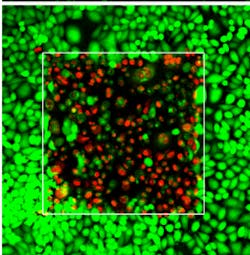| A laser-irradiated area in tissue (within the white square) shows live cancer cells (green) as well as cancer cells that have been killed (red) as a result of the irradiation. (Image: UB) |
Photodynamic therapy (PDT) is normally an effective treatment only for easily accessible tumors such as oral and skin cancer; however, researchers at the University at Buffalo (UB; Buffalo, NY), have developed a method for activating photodynamic drugs deeper in the body, making many other types of tumors accessible to the therapy.1
The technique depends on single-harmonic generation (SHG; also known as frequency-doubling) of IR light by natural body proteins. Near-infrared light (which travels much farther into tissue than visible light) irradiating a relatively deep tumor through the skin is frequency-doubled by collagen, a protein found in connective tissue; the resulting visible or UV light then photodynamically activates cancer-fighting drugs already in the body.1
The SHG happens when the natural proteins and lipids interact with the near-IR light through four-wave mixing and/or coherent anti-Stokes Raman scattering.
"We expect this will vastly expand the applications for an effective cancer phototherapy that's already in use," said co-author Tymish Ohulchanskyy, UB research associate professor and deputy director for photomedicine at the university's Institute for Lasers, Photonics and Biophotonics (ILPB).
"There are no long-term side effects for PDT, it's less invasive than surgery, and we can very precisely target cancer cells," says Paras Prasad, one of the UB researchers.
UB has applied for a patent, and the university's Office of Science, Technology Transfer and Economic Outreach (UB STOR) is discussing potential license agreements with companies interested in commercializing it.
The research is a collaboration between the ILPB, Shenzhen University in China, and Korea University in Korea, with which Prasad is affiliated.
REFERENCE:
1. A. V. Kachynski et al., Nature Photonics (2014); doi:10.1038/nphoton.2014.90
